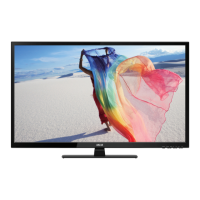
Do you have a question about the Akai AK32DLEDN and is the answer not in the manual?
Covers TV placement, ventilation, and material restrictions for safe operation.
Rules and restrictions for safe TV operation and environmental considerations.
Guidance on electrical safety, power cords, and plug handling.
Advice on TV placement, ventilation, and environmental factors.
Instructions for cleaning the TV screen and plastic parts.
Details on VESA mounting hole dimensions and screw requirements.
Step-by-step instructions for attaching and removing the TV stand.
Identifies front panel buttons and their functions.
Details all rear panel input/output ports and their uses.
Steps to connect the power cord and turn on the TV.
Guide for connecting the antenna for TV signal reception.
How to connect AV devices like DVD/VCR using AV cables.
Steps for connecting component video sources using YPbPr cables.
Instructions for connecting a PC using VGA and audio cables.
Guide for connecting devices via HDMI for high-quality video and audio.
How to connect audio output using coaxial (S/PDIF) cable.
Connecting USB devices for media playback and PVR functions.
Explains the function of each button on the remote in ATV mode.
Explains the function of each button on the remote in DTV mode.
Explains the function of each button on the remote in Teletext mode.
Guidelines for operating the remote control effectively.
How the volume level is displayed on screen and mute function.
How to navigate and adjust settings within the Channel menu.
Steps for automatically tuning TV channels for DTV and ATV.
How to manually tune ATV channels and adjust settings.
How to manually tune DTV channels and search for programmes.
Managing and editing recorded or scheduled programmes.
Viewing and managing the list of scheduled recordings.
Configuring settings for scheduling programme recordings.
Adjusting picture modes like Personal, Dynamic, Standard, and Mild.
How to adjust the contrast and brightness of the picture.
Adjusting tint, sharpness, and colour temperature for optimal picture.
Settings for noise reduction and the main Sound menu.
Configuring sound modes, treble, and bass levels.
Adjusting sound balance, auto volume, and S/PDIF output.
Setting the clock, time zone, and sleep timer functions.
Configuring auto standby duration and OSD display timer.
Enabling lock system, setting passwords, and blocking programs.
Blocking specific programs and setting parental controls.
Enabling key lock and configuring hotel mode settings.
Managing source locks and default program/source settings in hotel mode.
Configuring on-screen display and teletext language.
Adjusting audio languages, subtitle display, and hearing impaired features.
Managing PVR file system and adjusting aspect ratio.
Configuring blue screen, first-time setup, and factory reset options.
Automatically adjusting screen display for PC input.
Fine-tuning horizontal and vertical screen positioning.
Adjusting screen size and phase for optimal PC display.
Restoring the screen position to its default settings.
Preparing and formatting USB devices for recording.
Setting record limits and initiating PVR recordings.
Viewing and playing back recorded programmes.
Configuring and using time-shift playback for digital TV.
Browsing and viewing photos, including slideshow features.
Playing music files, managing playlists, and controlling playback.
Playing video files, controlling playback, and adjusting aspect ratio.
Viewing text files and controlling text playback.
List of supported media file formats, codecs, and audio types.
General tips for keeping the TV in good condition.
Detailed instructions for safely cleaning the TV screen and plastic parts.
Guidelines for environmentally responsible disposal of the appliance.